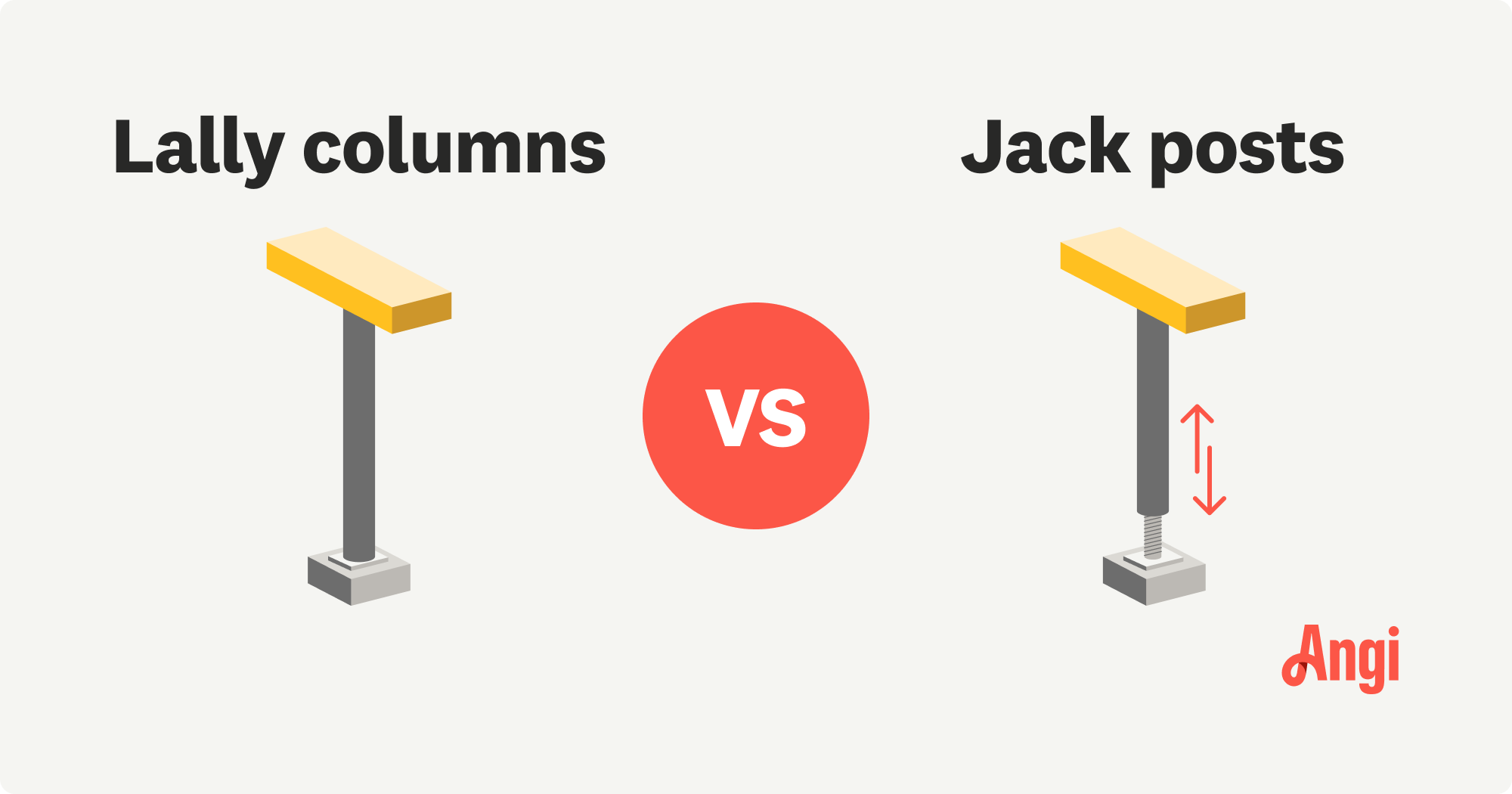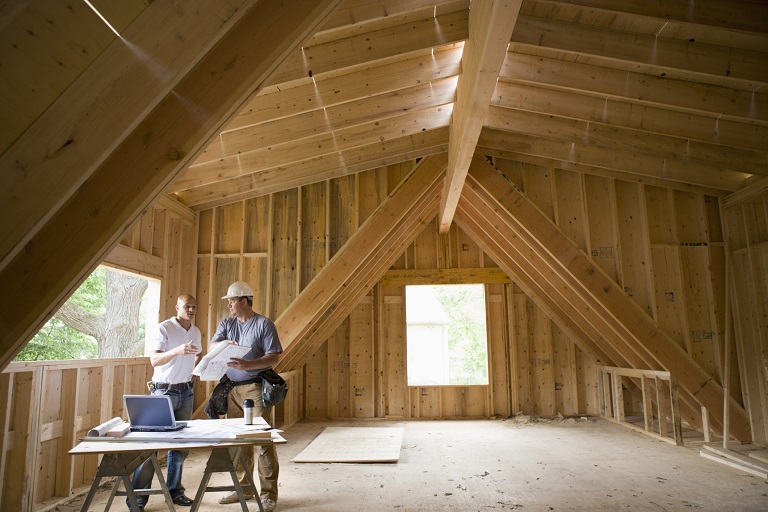
The cost of a structural engineer is easily justifiable given the value they bring to the table. Use this guide to see what hiring your professional will total in Seattle, WA.
Fix sloping floors or sagging beams with this simple solution


Lally columns are a simple structural solution to support big loads.
Knocking a wall down is doable with temporary Lally columns.
Installing Lally columns starts at $2,500.
Whether you’re tearing down a load-bearing wall or solving a sagging flooring problem, a Lally column offers either a temporary or permanent solution to hold up structural weight in your home. Learn more about what a Lally column is and how its straightforward design can fortify your home from the basement up.
A Lally column is a thin, round steel pipe—often found in the basement—that supports beams extending over long spans and prevents structural problems from occurring. Engineers and construction companies can use Lally columns to correct saggy floors or beams and for additional fortification when remodeling a wall or entryway or replacing a load-bearing column or wall.
Lally columns also offer a simple and minimalistic look that fits modern home design, so while they’re more common for temporary support, you can also rely on them for permanent support. Most homeowners only use them for permanent support in basements or crawl spaces, though, or they build more decorative coverings for them if they use them in their main living area.
Lally columns can range in height from about 1 foot to 12 feet or more, and they sit between the foundation or a supported section of the flooring and a structural beam or rafter above. They bridge the gap between other supporting posts or load-bearing walls, and they can hold thousands of pounds.
Columns that are shorter in height are able to withstand greater loads. Lally columns are sometimes filled with concrete to provide extra strength, in which case they can support permanent structural loads of up to 60,000 pounds. This kind of strength is more often reserved for commercial or industrial buildings, though.
Lally columns are an important tool contractors use when carrying out home renovations, and they come with some pros and cons over other supports.
There are a few key benefits to using Lally columns in your home.
They’re great for maintaining temporary support during major renovations.
You can leave them in place to maintain permanent support.
They can hold around 30,000 pounds each, on average, or up to 60,000 pounds if they’re filled with concrete.
They’re relatively easy for a professional to install.
Of course, there are some drawbacks to using Lally columns as well.
They aren’t particularly decorative, so you might need a nicer enclosure around them if you’re using them for permanent support.
They have a fixed height, so you can’t use them to push a sagging beam back into place.
The upfront cost can be high.
Lally columns and jack posts are similar, but there are a few key differences.

The most important difference is that you can use Lally columns for temporary or permanent support, so they’re useful whether you’re replacing a load-bearing wall or taking down the wall altogether to open up the space. A jack post, on the other hand, is only meant to provide temporary support, so it’s only useful for short-term use while you replace an existing load-bearing wall or install a steel I-beam or LVL beam.
Additionally, Lally columns have a fixed height, while jack posts act as jacks and can extend to lift a sagging beam or joist back into place.
For these reasons, jack posts are more common for restoring structural stability or making repairs when there are signs of structural issues, while Lally columns are more common for maintaining stability.
Adjustable Lally columns are usually hollow and act as temporary columns. More often called jack columns, adjustable Lally columns consist of two steel tubes that fit together and adjust—up or down—to carry the weight of an unsupported joist or beam. Foundation repair projects often use this type of post.
Non-adjustable Lally columns are made of steel, and your contractor may cut to fit the needed length. Lally columns come in standard sizes based on ceiling height, so cutting usually isn’t necessary.
Your contractor might use temporary columns to brace the joists of the floor above when removing a load-bearing wall. Temporary lally columns are usually unfinished and aren’t decorative.
Permanent columns most often appear under a house, in the crawl space or basement, to support the structure. They still aren’t the most decorative of supports, but they’re finished or painted to look a bit better than raw metal. Some homeowners will build decorative boxes around permanent Lally columns if they appear in the main living area.
If you’re repairing a flooring problem or knocking down a wall, you’ll probably need to install some Lally columns, permanently or temporarily. Here are the steps included in Lally column installation:
A structural engineer will inspect your home and provide a report with the support your roof or upper floor needs, which will determine the Lally column’s size, footing, and the number of columns over a certain span.
Some warning signs of structural damage in your home include curving interior walls, horizontal cracks in the foundation, and sagging floors or roofs. Calling in a structural engineer to take a look as soon as you notice these signs can save you from a bigger problem later on.
Installing permanent Lally columns will likely need a building permit and an inspection. Your basement contractor should be able to help you file and obtain the necessary permit.
You’ll need to attach all Lally columns to the floor, so a contractor will dig down and pour concrete to form the footing, if necessary, or bolt them in place. The footer should be at least 2-feet-by-2-feet in size and 12-inches deep. The footing must cure for at least a week before placing the new post.
You can set Lally columns in place of a wall to keep the house structurally sound or fix a sagging beam. Based on the report from the structural engineer or architect you hire, your contractor can determine the correct size, number, and position of Lally columns.
The contractor should prime and finish the Lally columns before installing them on top of the footings.
Installing a Lally column costs around $2,500, on average. The price depends on many factors, such as basement condition, structural support, and the condition of the existing beams. You could pay anywhere from $1,000 to $4,000 or more per column, based on the width and height.
From average costs to expert advice, get all the answers you need to get your job done.

The cost of a structural engineer is easily justifiable given the value they bring to the table. Use this guide to see what hiring your professional will total in Seattle, WA.

The cost of a structural engineer is easily justifiable given the value they bring to the table. Use this guide to see what hiring your professional will total in Orlando, FL.

The cost of a structural engineer is easily justifiable given the value they bring to the table. Use this guide to see what hiring your professional will total in Columbus, OH.

Do you have a load-bearing wall standing between you and your projects that you want to remove? Learn about the cost of removing a load-bearing wall.

Keeping your home safe and structurally sound should be a top priority. Learn to recognize the signs of structural damage you should never ignore.

A home doesn’t collapse unexpectedly. Learn the warning signs that a house will collapse, so you can protect your family and your home.